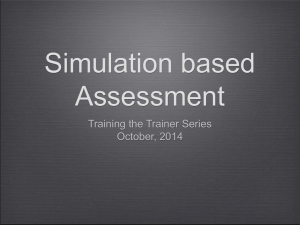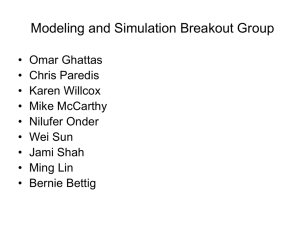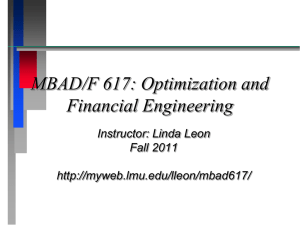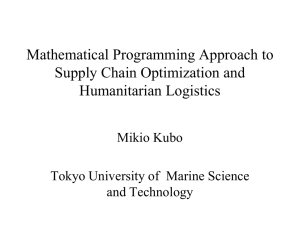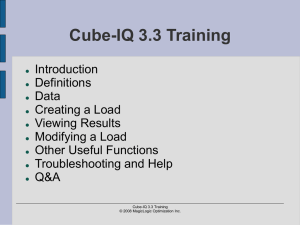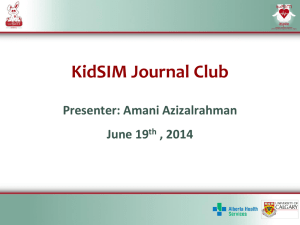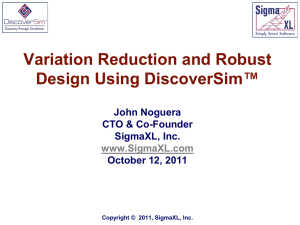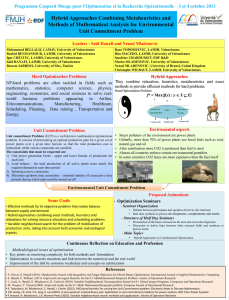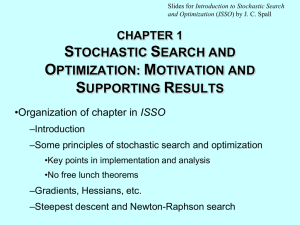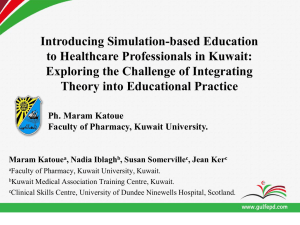presentation
advertisement
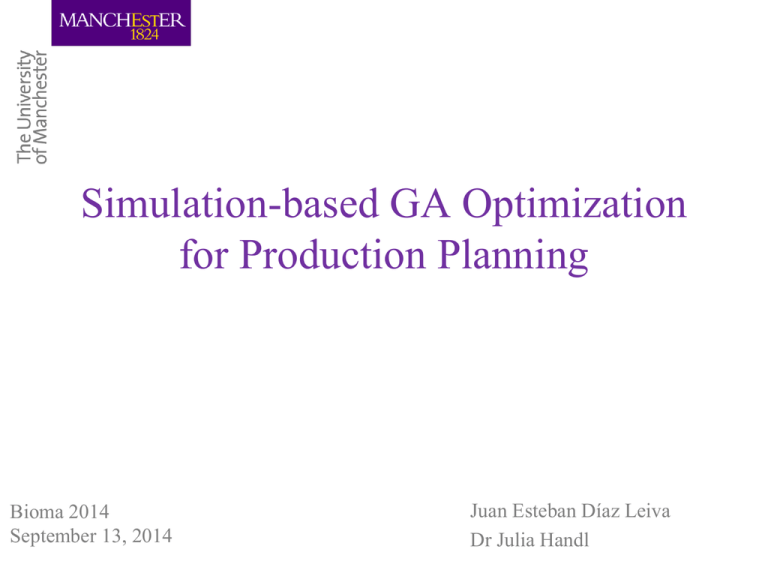
Simulation-based GA Optimization for Production Planning Bioma 2014 September 13, 2014 Juan Esteban Díaz Leiva Dr Julia Handl Production Planning Production levels Production Plan Allocation of resources Business objectives 2 Production Planning Experience & “Sixth sense” Lack of appropriate instrument Inappropriate methods 3 Simulation-based Optimization Simulation Optimization DES GA Aplicable solution 4 Objective Support decision making Production Planning Feasibility Simulation-based optimization Uncertainty & Real-life complexity Applicablility Robustness 5 Simulation-based Optimization Model 6 Figure 1. Order processing subsystem for work centre 𝑙. Simulation-based Optimization Model Figure 2. Production subsystem for work centre 𝑙. Figure 3. Repair service station of work centre 𝑙. 7 Simulation-based Optimization Model minimize: 1 𝑓 𝑥 =𝑐= 𝑛 𝑛 𝑐𝑚 (𝑚 = 1, 2, . . . , 𝑛) 𝑚=1 subject to : 𝑥𝑗 ∈ S 𝑥𝑗 ∈ ℤ≥ (𝑗 = 1, 2, . . . , 41) (𝑗 = 1, 2, . . . , 41) 𝑛: number of replications 𝑓: fitness function value 𝑥: vector of decision variables 𝑥𝑗 𝑐 expected sum of backorders and inventory costs 8 Simulation-based Optimization Model 31 𝑐𝑚 = 𝐼𝑛𝑣𝑒𝑛𝑡𝑜𝑟𝑦𝐶𝑜𝑠𝑡𝑘 + 𝐵𝑎𝑐𝑘𝑜𝑟𝑑𝑒𝑟𝐶𝑜𝑠𝑡𝑘 𝑘=1 where 𝐼𝑛𝑣𝑒𝑛𝑡𝑜𝑟𝑦𝐶𝑜𝑠𝑡𝑘 = 𝑆𝑡𝑜𝑐𝑘𝑘 − 𝐷𝑘 × 𝐶𝑜𝑠𝑡𝑘 0 𝐵𝑎𝑐𝑘𝑜𝑟𝑑𝑒𝑟𝐶𝑜𝑠𝑡𝑘 = 𝐷𝑘 − 𝑆𝑡𝑜𝑐𝑘𝑘 × 𝑃𝑟𝑖𝑐𝑒𝑘 0 𝐷𝑘 : demand if 𝑆𝑡𝑜𝑐𝑘𝑘 > 𝐷𝑘 if 𝑆𝑡𝑜𝑐𝑘𝑘 ≤ 𝐷𝑘 if 𝑆𝑡𝑜𝑐𝑘𝑘 < 𝐷𝑘 if 𝑆𝑡𝑜𝑐𝑘𝑘 ≥ 𝐷𝑘 9 Simulation-based Optimization Model Requirement of sub-products 41 𝑎𝑖𝑗 × 𝑥𝑗 ≤ 𝑏𝑖 (𝑖 = 1,2, … , 4) 𝑗=1 𝑏𝑖 : quantity available of sub-product 𝑖 𝑎𝑖𝑗 : amount required of sub-product 𝑖 to produce one lot in process 𝑗 10 Simulation-based Optimization Model GA (MI-LXPM) [2] • • • • • • real coded Laplace crossover power mutation tournament selection truncation procedure for integer restrictions parameter free penalty approach [1] [1] K. Deb. An efficient constraint handling method for genetic algorithms. Computer methods in applied mechanics and engineering, 186(2):311-338, 2000. [2] K. Deep, K. P. Singh, M. Kansal, and C. Mohan. A real coded genetic algorithm for solving integer and mixed integer optimization problems. Applied Mathematics and Computation, 212(2):505-518, 2009. 11 Results Original model Figure 4. Best, mean and worst fitness value of the population at each iteration. 12 Results Model modifications Figure 5. Order processing subsystem for work centre 𝑙. 13 Results Model modifications Figure 6. Production subsystem for work centre 𝑙. 14 Results Profit maximization 15 Figure 7. Best, mean and worst fitness value of the population at each iteration (time: 8.17 h). Results ILP CDF deterministic Stochastic Simulation Simulation-based optimization CDF uncertainty 16 Results Profit maximization 17 Figure 8. CDFs of profit obtained through stochastic simulation. Conclusions Production plan • production levels and allocation of work centres Process uncertainty • delays Real life complexity • no complete analytic formulation Better performance of solutions • stochastic simulation 18 Post-doc Position Constrained optimization (applied in the area of protein structure prediction) Start date: November 2014 in collaboration between: Computer Sciences (Joshua Knowles), Faculty of Life Sciences (Simon Lovell) and MBS (Julia Handl). Info: j.handl@manchester.ac.uk 19 Q&A 20 Thank you September 13, 2014 Juan Esteban Diaz Leiva Dr Julia Handl 21


